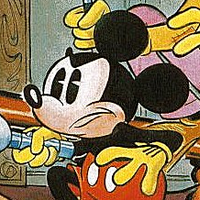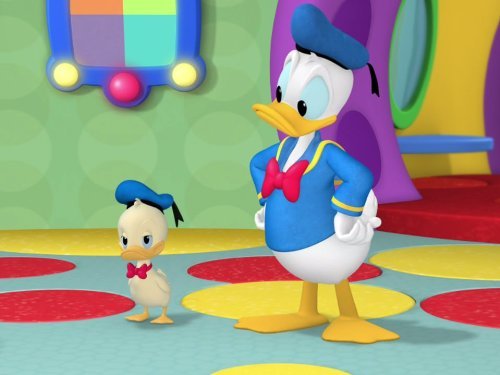Post by drakeborough on Jun 28, 2017 13:20:50 GMT
We can use this new thread to stop the OT in the discussion in the thread Elroy, Ellsworth, Pluto, Goofy, what's an animal and what's a person. Before continuing the discussion, I'll copy here the relevant messages.


I agree with almost everything you said here, however I think there are other things that make Quack Pack non-canon to the comics rather then the presence of humans. After all, you and I both see all of Duckburg inhabitants (including Donald and his relatives) as actually being humans that just happen to be often drawn with animal features as part of a charicature, so I don't think there's anything wrong if the "lens" that gives them their animal features is sometimes turned off, as long as this only happens to the extras and not to Donald or any character with an established design: after all, there are many precedents of humans as extras in both animation and comics taking place in the Duck and Mouse Universe.
That said, I would use dognoses rather than humans if I were an artist of Disney comics.
I wouldn't say that Max was carried to the standard Mouse comic universe. He appears in 40 comics (though anothe Inducks page oddly lists only 39 stories), and 37 of them are set in the Goof Troop universe. As for the other 3 stories: the first stars Goofy and is apparently set in the normal universe, and Max' appearance is so odd that Inducks put an exclamation mark after his name in the list of characters, the second is an adaptation of Mickey's Twice Upon a Christmas, and the third (in which Max only has a cameo) is set in the Darkwing Duck universe, which is a Disney Afternoon show, not to mention that it is connected to DuckTales rather than to the classic comics.
As far as the standard Mouse universe goes, Goofy has no son (minus the single example that I listed above) and he is definitely a bachelor and not a vidower. Because of that, I find it annoying when someone tries to indicate various female characters from the Mouse comic universe as the possible mother of Max. It's only the animation that (unfortunately) kept Max even after the Goof Troop show and movies ended, though it seems that they removed it from most recent productions, which is a good thing.


On an other note enitrely, in my view of continuity, it's easy to reconcile Max with Goofy's apparent son-lessness: House of Mouse, generally agreed to take place a few years after An Extremely Goofy Movie (the chronologically last work set in the Goof Troop series), shows Max having a job as a doorman. Indeed, from Goof Troop to A Goofy Movie to An Extremely Goofy Movie to House of Mouse, Max is seen steadily aging from a twelve-year-old to an adult, a unique case in Classic Disney paraphernalia, I believe. At any rate, it's easy to assume that Gottfredson stories took place when Goofy was still single, and that recent stories that have him single again take place when Max is already an independant young man.


Actually, I'd say that a recurring element of Goofy's theatrical cartoons in the 50's and 60's is that... they didn't feature Goofy at all! Disney often regards their characters as actors playing roles (in animation more than in comics), and this idea was heavily used in the Goofy cartoons of the time, in which at first we were introduced to a world in which everyone is a Goofy lookalike (none of which was the "real" one), and then the series focused on one of them, George Geef, who could do things that Goofy cannot.
The fact that George is not Goofy is indicated by many clues: the fact that we were introduced to him through the device of a world populated by Goofy lookalikes, the fact that his appearance was gradually changed until he was noticeably different from Goofy, the fact that he has a different name, the fact that his life and personality were often different from Goofy's, etc. So, if George Geef is not Goofy, then it is true that, prior to Goof Troop, Goofy was always portrayed as being a bachelor who had no children. Because of that, it was annoying to see what was intended to be the real Goofy suddenly being a father of a pre-teen, effectively creating a schism between animation and comics, as the differences here were far bigger than whatever change DuckTales made from the Uncle Scroge comics.
By the way, this is in my opinion the real reason why we often see nephews/nieces in the Duck and Mouse universe rather than sons and daughter. I don't think it's a matter of censorship as many people say, it's just that when you have unpteen stories establishing that a character has no children you can't have a grown child appearing out of nowhere in the character's (unpteen+1)th story as if the child has always been there. Or, you could do it (and, in the case of Goof Troop, they did it), but it would violate everything about the established continuity, possibly disappointing readers/viewers who feel their intelligence has been insulted. That's why giving a character a nephew/niece is often the only way to create stories in which he/she interacts with a kid.

On an other note enitrely, in my view of continuity, it's easy to reconcile Max with Goofy's apparent son-lessness: House of Mouse, generally agreed to take place a few years after An Extremely Goofy Movie (the chronologically last work set in the Goof Troop series), shows Max having a job as a doorman. Indeed, from Goof Troop to A Goofy Movie to An Extremely Goofy Movie to House of Mouse, Max is seen steadily aging from a twelve-year-old to an adult, a unique case in Classic Disney paraphernalia, I believe. At any rate, it's easy to assume that Gottfredson stories took place when Goofy was still single, and that recent stories that have him single again take place when Max is already an independant young man.
I really admire, and I am not ironic, the cleverness of your explanations with which you always try to find a way to tie everything (in this case, Max' existence) together in a single continuity: I am really amused by it. I guess you also have an explanation for Pete's wife and children, and for why they live in Spoonerville rather than Mouseton, and I can image what it may be.
That said, I am not really convinced by these arguments: for example, why didn't HDL age between Goofy not being a father yet and Max being almost an adult (I am not sure if working as a doorman necessarily means you are an adult)?
My explanation is simply that Goof Troop is non-canon to the Mouse universe comics, and in my headcanon Max doesn't exist.


Actually, the wife was known as "Mrs. Geef", since she wasn't really Goofy's wife but rather the wife of a Goofy lookalike named "George Geef". And the son was named "Junior". We already discussed this on this very thread, but the subject was quickly dropped because it was OT; maybe we could open a separate thread about it.


Actually, the wife was known as "Mrs. Geef", since she wasn't really Goofy's wife but rather the wife of a Goofy lookalike named "George Geef". And the son was named "Junior". We already discussed this on this very thread, but the subject was quickly dropped because it was OT; maybe we could open a separate thread about it.


I am curious about something: I can understand why you would accept Goof Troop and derivates, and Max' character in general, as being part of your headcanon. But what is your objection to the idea of George Geef not being the real Goofy? I think the producers of these shorts made the idea clear in many ways, including giving him a different name.


It seems that our messages are overlapping, as by the time I finish writing a message with a question you have already published a message that coincidentally contains the answer. Good to see that the you liked the idea of opening another thread.
As for Goofy's name: "Goofy" started as a nickname of "Dippy Dawg", so if the producers of Goofy cartoons of the 50's and 60's wanted a full name they could have used that. No, I think "George Geef" wasn't meant to be Goofy real name but just one of the many clues to the audience that we weren't supposed to think of him as the real Goofy but rather as just a Goofy lookalike. I guess that finding an interview to the producers, or reviews from animation historians, would help clarify the issue.
Perhaps we can move some of these messages to a thread about the portrayal of Duck and Mouse characters in the cartoons?



